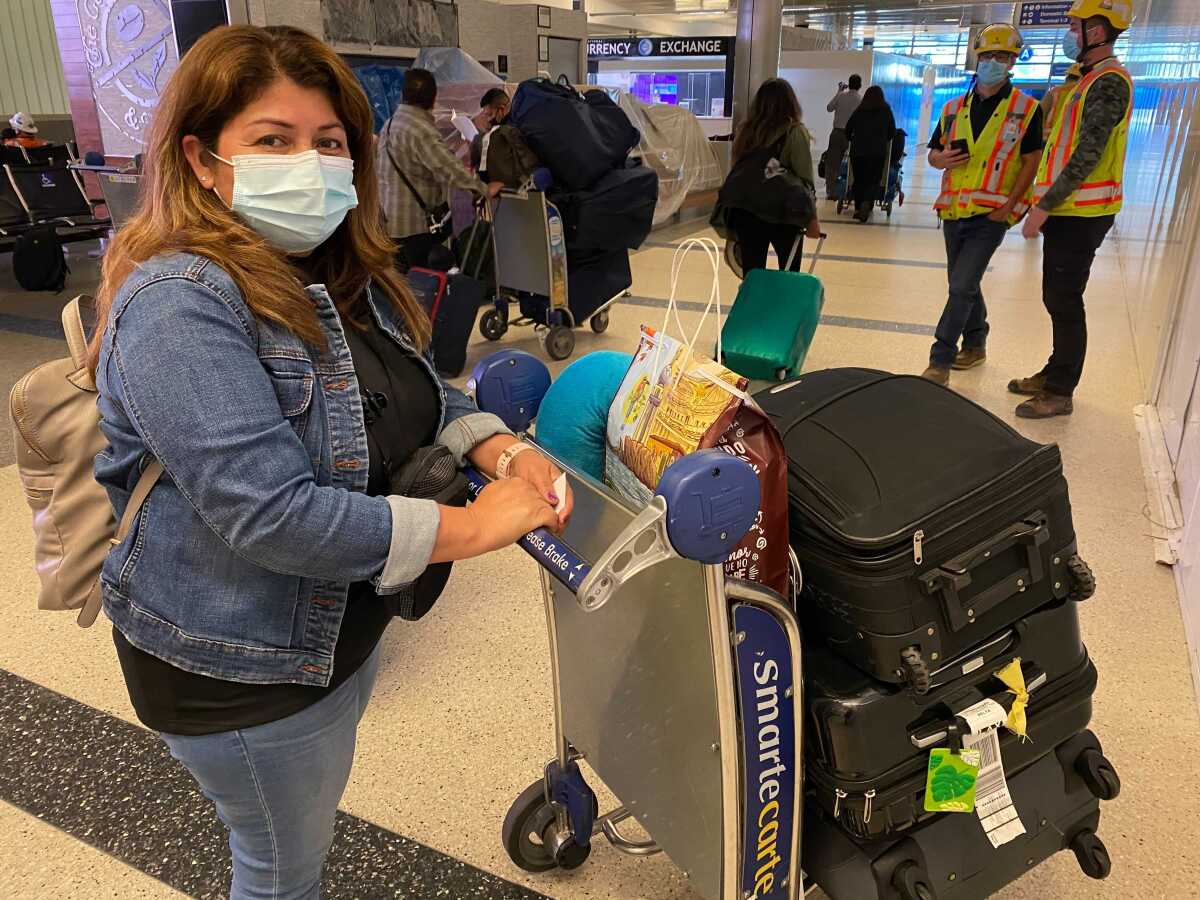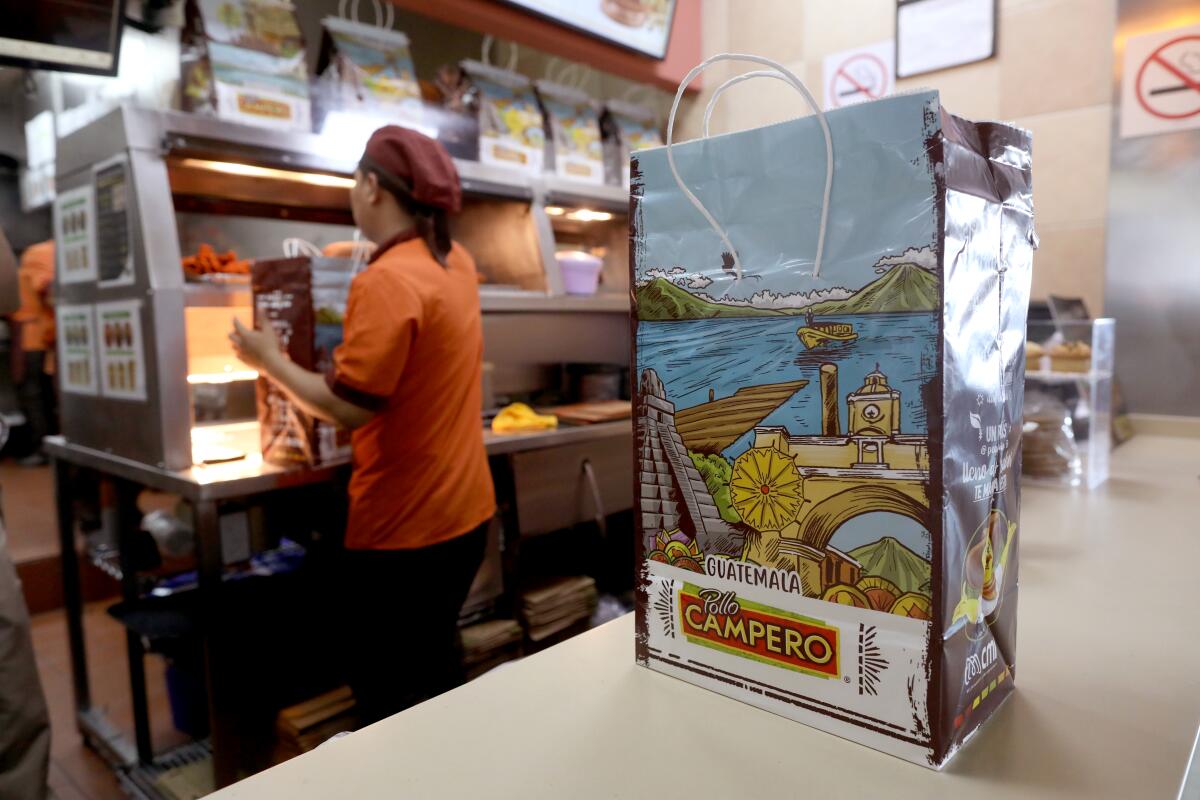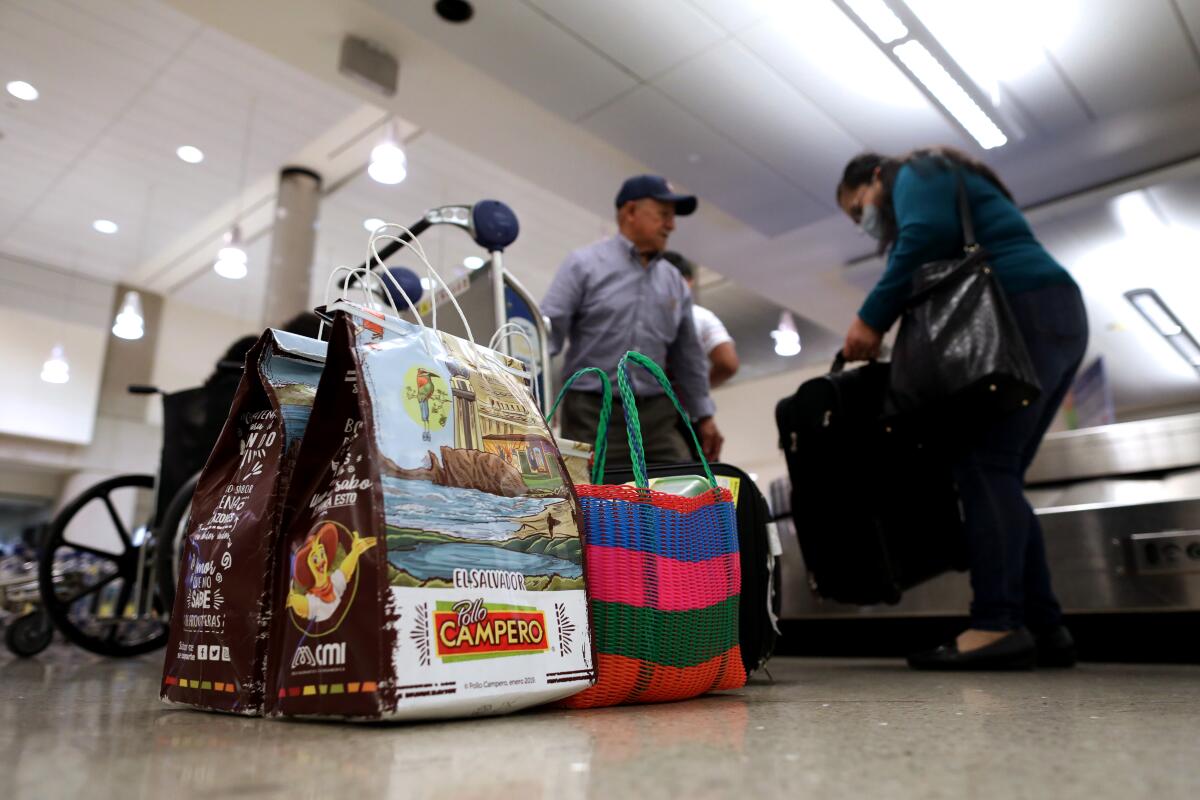Why flights from Central America often have the enticing aroma of fried chicken

- Share via
Norma Ramirez stepped off Delta flight 1903 from Guatemala City with a backpack, a blue neck pillow and an aromatic carry-on: chicken.
Lots and lots of fried chicken.

This year, in late March, the 54-year-old came back to Los Angeles after spending two weeks with her husband’s family. As she does almost every time she leaves her home country of Guatemala, Ramirez carried boxes of Pollo Campero.
Her husband had returned with a 12-piece box after a trip in December, and now it was her turn to honor the ritual. This time, she was joined on the five-hour flight by 30 wings and an eight-piece combo.
“It reminds me of my childhood,” said Ramirez, as she wheeled three suitcases and her precious cargo on a luggage cart through Los Angeles International Airport.
For years, people have flown from Central America to the U.S. bearing Pollo Campero. Plane cabins become infused with the distinct scent of deep-fried chicken. Relatives who otherwise avoid the snarl of the 405 and 105 freeways at rush hour suddenly brave a trip to LAX to pick up their chicken-carrying kin.

Can Times staffers Brittny Mejia, Cindy Carcamo and Ruben Vives tell the difference between the U.S. and Central American versions of Pollo Campero?
The COVID-19 pandemic temporarily halted Operation Chicken Airlift after the international airports in El Salvador and Guatemala shut down a year ago. But now — with the airport restaurant locations open once more — the chicken express is back in business.
Not that there’s a shortage of Pollo Campero restaurants in the U.S. They number almost 100 nationwide, including 17 in California. A company spokeswoman insists that the U.S. outlets “use the exact same recipe and marination process as our Guatemalan partners.”
But for many Guatemalans and Salvadorans, the American chicken lacks a key ingredient: home.
Where nostalgia goes, taste buds follow. People fly Zabar’s bagels from New York to California and In-N-Out burgers to the East Coast. But Pollo Campero’s route north is different — it follows contrails of war and heartbreak.
The first Pollo Campero opened its doors in Guatemala in 1971, and the chain quickly spread across Central America. Soon after, civil wars erupted in El Salvador and Guatemala, and hundreds of thousands of immigrants left behind the people, places and things they loved to move to the U.S. Many settled in L.A., which as of 2018 had more than half a million residents of Central American origin.
Before Pollo Campero spread its wings across the U.S., the chain estimated that it sold more than 3 million to-go orders annually through outlets at La Aurora International Airport in Guatemala and San Salvador International Airport in El Salvador.

For years, the joke went: If you don’t bring back Pollo Campero, did you even go to Central America?
When news came of the opening of a Pollo Campero in the U.S. — in 2002 in the Pico-Union neighborhood of L.A. — there were more than 900 job applications. Patrons waited in line for six to eight hours. That outlet, which hit $1 million in sales in about a month, is now one of the chain’s best-selling restaurants worldwide. The company — which has 130 locations in Guatemala and about 70 in El Salvador — plans to open 30 more restaurants in California in the next five years.
Before the pandemic hit, to-go orders at the two Central American airports stood at nearly 400,000 annually, company executives said. While a dramatic drop, that was still a lot of pollo traveling coach to the U.S.
“It’s a way of remembering culturally what is offered in the country of origin,” said Douglas Carranza, chair of the department of Central American studies at Cal State Northridge. “That doesn’t mean that Pollo Campero is everything. But it’s a little piece.”
“I don’t think that the chicken is amazing, but what gets me every time is just that feeling of home. When you miss home, you miss everything about it.”
— Cesar Valencia
Cesar Valencia knows Pollo Campero originated in Guatemala a year before it came to El Salvador, where he was born, but says Salvadorans have “adopted the chain as our own.”
Valencia immigrated to the U.S. when he was 5, and it became a tradition to ask family members to bring Pollo Campero when they visited. Picking up a box in the airport, he said, “is the very last thing you can do to feel connected to El Salvador.”
“It’s the one thing, next to pupusas, that we all can relate to,” the San Fernando Valley resident said. “Even second-generation Salvadorans connect with it.”
When his parents brought back a small order from Pollo Campero after a monthlong trip to El Salvador, they heated up the chicken, but Valencia didn’t wait and ate it out of the box cold.
“I don’t think that the chicken is amazing, but what gets me every time is just that feeling of home,” he said. “When you miss home, you miss everything about it.”

Across social media, via a torrent of memes, tweets and YouTube videos, taste comparisons attempt to answer one question: Does Pollo Campero really taste different in Central America than in the U.S.?
For example, two sisters made a video of themselves trying Pollo Campero in the U.S. for the first time, in Katy, Texas.
“I feel like I’m in El Salvador,” Julianna Morgan said, breaking out in a smile as she held a chicken breast to her nose and took a big whiff.
Morgan, who was raised in El Salvador, was inspired to make the video after her grandmother told her Pollo Campero “wasn’t too bad in the States.”
But after a bite, Morgan concluded that the flavor wasn’t as powerful. The chicken in Central America “is a lot more natural, and you can really taste the difference.”
There is one way in which Pollo Campero chicken is very different in Central America. Like a hulking 1990s Major League Baseball slugger pumped on steroids, the American chicken has an enormous breast compared with that of a Central American bird.
Even so, Luis Javier Rodas, managing director and chief operating officer at Campero USA, said, “the process, the product, the formula — everything is exactly the same. There is no difference.”
But Antonio Cabrera, who returned to the U.S. from Guatemala in February with a 20-piece box, proclaimed: “It’s the same recipe, but not necessarily the same chicken. The Guatemalan chicken is definitely more organic than the chicken here.”

So it was with an air of celebration that he told Tekandi Paniagua, his friend and Guatemala’s consul general in L.A., that he had brought him some Pollo Campero from home.
“Va, OK, está bien,” Paniagua responded. He didn’t get any that time, but he did this past Saturday, after Cabrera’s brother brought a box.
“I grew up with Pollo Campero, but I don’t die for it,” Paniagua said. But other people? “People die for that chicken.”
One afternoon, before COVID-19 restrictions were in place, more than a dozen people filled booths and tables inside the Pico-Union Pollo Campero.
“Pollo, pollo, pollo!” a 5-year-old boy shouted from his table, which, like every other one, had a bottle each of Cholula hot sauce and Heinz ketchup. The boy’s father, Balmore Diaz, wearing a blue-and-white “El Salvador” shirt, had become a U.S. citizen earlier that day, and this was their celebratory meal.
Like many of his countrymen, Diaz has brought back Pollo Campero on flights.
“Allá, es original,” he said, with a smile. “Over there, it’s original.”
Another diner, Veronica Calderon, agreed.
“It’s not the same. They tried to do it, but ... ” she trailed off, shaking her head. The aroma is good, but nowhere near as strong as it is at Pollo Camperos in Guatemala. Back there, she said, you could smell the chicken two blocks away.
Calderon is convinced that the U.S. stores tried to buy the recipe but did not succeed.
A young Pollo Campero worker seated outside was less convinced. The teenager, wearing a black hairnet, had arrived from Guatemala five years earlier, and this was his first day of work. His orange shirt read “Getting seasoned.”
To him, the chicken tasted the same. But his parents swear there’s a difference.
“Tal vez estará en la mente,” he said. “Maybe it’s in the mind.”
That’s clucking pride for you.
Times staff writer Cindy Carcamo contributed to this report.
More to Read
Sign up for Essential California
The most important California stories and recommendations in your inbox every morning.
You may occasionally receive promotional content from the Los Angeles Times.









